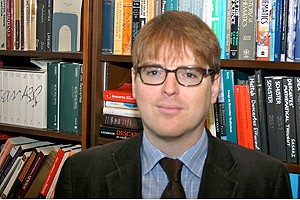
Newton's Physics Has Mass Appeal for New Philosophy Professor
Zvi Biener, a new assistant professor in the Department of Philosophy, recently co-authored an essay with Christopher Smeenk, of Western Ontario University, titled, Cotes Queries: Newtons Empiricism and Conceptions of Matter. The essay is on Isaac Newton and his struggle to determine the essential properties of matter and how that struggle led to the modern notion of mass.
Before Newton it was thought that matter had necessary geometric propertiesit didnt have any other fundamental properties except that it took up space, Biener explains. After Newton it was thought that matter had necessary inertial propertiesit has mass. It can resist and interact with forces, but its geometric properties play little role in fundamental physical explanations.
The fact is, it was unclear to Newton how matter can have both geometric and inertial properties, and he wrestled with how the two can exist together, and which property, if either, was most important. This was no mere conceptual quibble. The validity of Newtons argument for universal gravitation depended his understanding of the fundamental properties of matter.
Eventually, Newtons experimentation led him to the conclusion that inertial mass was the essential property of matter, and that matter may not have geometric properties at allit may not take up any space whatsoever! This conclusion ended up changing the way we think about matter.
The essay is part of my larger project of figuring out the changing interrelations between mathematics, physical science and metaphysicsthe study of existence and the broadest categories of beingin the 17th century, says Biener.
Besides his work in the philosophy of science, Biener also studies the history of science. He says that by paying attention to the history of science, philosophers can pose better philosophical questions, questions that are not only deep, but scientifically informed.
Last year, the historian inside Biener led him to start a pilot project mapping the history of science. The mapping project aims to take historical information, like the transmission of letters between historical actors or the movement of scientific instruments, and make it available as a searchable, visual database.
Say Galileo makes a telescope in Venice, where does it go after that? Does he make several copies? Where do they go? Say theres a book on astrology printed in Amsterdam, how does it get distributed? Where does it go? If we could trace that we could find coincidences. If in one location we find Galileos telescope and also this book, is there a connection?
The mapping project also relates to philosophy because contemporary philosophers use historical examples as fodder, especially in the McMicken College of Arts and Sciences philosophy department.
This department is very strong in what I like to call `philosophy in the concretewere always paying attention to whats going on in the actual sciences or in real world practical affairs when posing and answering philosophical questions. And so providing an engine by which to trace scientific developments is very useful for philosophers.
In fact, this approach to philosophy is the reason Biener wanted to come to UC. This department is very good in scientifically-informed philosophy and is very welcoming to approaches that are interdisciplinary in nature. This is a really great place to be.
Related Stories
Ohio to see Senate showdown
August 13, 2025
UC Professor David Niven explains significance of 2026 U.S. Senate race in Ohio.
‘Full Body Burden’ becomes a documentary
August 13, 2025
The book, “Full Body Burden: Growing Up in the Nuclear Shadow of Rocky Flats” by UC faculty member Kristen Iversen will hit the big screen in 2026, with a prescreening to take place in summer 2025.
Pregnant roaches need more sleep, too
August 13, 2025
Science outlets highlight UC research examining the role sleep plays in insect models such as the Pacific beetle-mimic cockroach.
